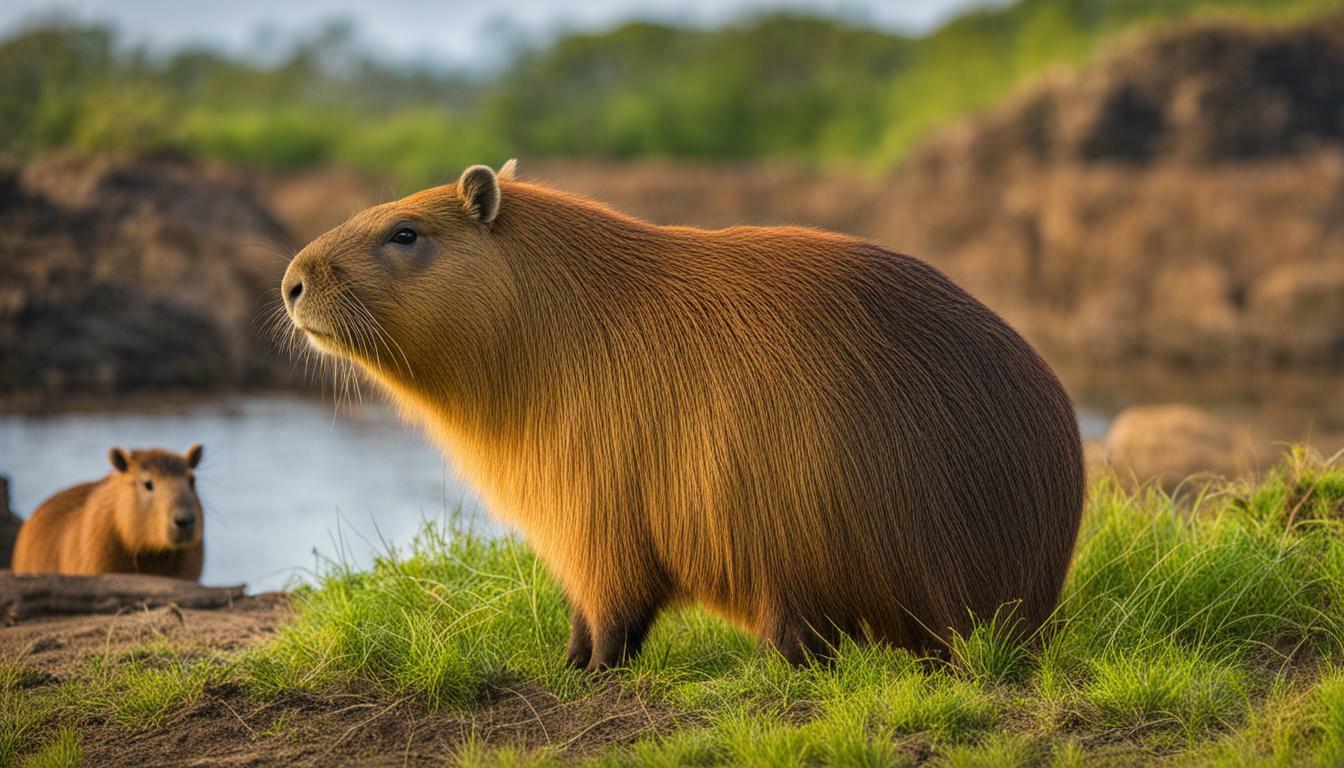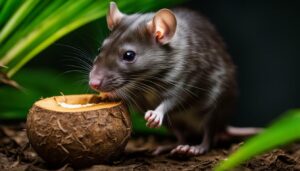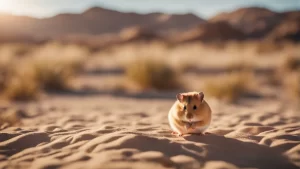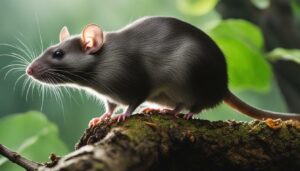The capybara, an intriguing South American rodent, is indeed classified as a vertebrate. Belonging to the class Mammalia and order Rodentia, the capybara is the largest living rodent. Its scientific name is Hydrochoerus hydrochaeris. Native to South America, capybaras can be found in savannas and dense forests near bodies of water. With their barrel-shaped body, short head, and reddish-brown fur, they possess unique physical features.
Key Takeaways:
- The capybara is the largest living rodent and is native to South America
- Capybaras belong to the class Mammalia and order Rodentia
- They have a barrel-shaped body, short head, and reddish-brown fur
- Capybaras are herbivores and primarily feed on grasses and aquatic plants
- They are highly sociable animals and often live in groups of up to 100 individuals
- Capybaras have a lifespan of 8-10 years and can hold their breath underwater for up to 5 minutes
- They have predators such as jaguars, pumas, and anacondas
- Capybaras are hunted for their meat and hide
- They are not considered a threatened species
Capybara Classification
Capybaras belong to the class Mammalia and the order Rodentia, making them fascinating members of the animal kingdom. As the largest living rodent, capybaras have captured the curiosity of many due to their unique characteristics and specialized adaptations. Let’s explore further the classification of these intriguing creatures.
H3: Capybara Order and Family
Within the order Rodentia, capybaras are classified under the family Caviidae. This family includes other species of cavies and guinea pigs. Despite their rodent classification, capybaras stand out from other rodents due to their semi-aquatic lifestyle and social behaviors.
H3: Capybara Genus and Species
The scientific name for the capybara is Hydrochoerus hydrochaeris. The genus name Hydrochoerus derives from the Greek words for “water” and “hog,” reflecting their affinity for aquatic habitats. The species name hydrochaeris refers to their preference for living near bodies of water.
H3: Capybara Evolutionary History
Capybaras have a long evolutionary history that traces back to the Miocene epoch. Fossil evidence suggests that their ancestors were smaller and more terrestrial compared to the modern-day capybara. Over time, these early ancestors adapted to their semi-aquatic environment, developing their unique physical features.
In conclusion, capybaras are captivating creatures that belong to the class Mammalia and the order Rodentia. Their classification within the animal kingdom highlights their distinctiveness as the largest living rodents. By understanding their classification, we gain insight into the evolutionary journey that has shaped these fascinating semi-aquatic mammals.
Capybara Facts
Capybaras are notable for being the largest living rodent, sporting a barrel-shaped body, short head, and reddish-brown fur. They are native to South America and are found in savannas and dense forests near bodies of water. These semi-aquatic creatures have adapted well to their surroundings, with webbed feet that enable them to swim effortlessly.
As herbivores, capybaras primarily feed on grasses and aquatic plants. Their grazing habits make them an important part of the ecosystem, as they help control vegetation growth. Capybaras are highly social animals and can often be spotted in large groups, known as herds or colonies, consisting of up to 100 individuals. These tight-knit communities allow for increased protection against predators and facilitate the sharing of resources.
Another fascinating fact about capybaras is their ability to hold their breath underwater for up to 5 minutes. This remarkable skill allows them to submerged themselves to escape from predators or to forage for food beneath the water’s surface. Additionally, capybaras have a lifespan of 8-10 years in the wild, although they can live longer in captivity where they are protected from natural threats.
In their natural habitat, capybaras face a variety of predators, including jaguars, pumas, and anacondas. These animals rely on capybaras as a source of food due to their abundance and accessible nature. Unfortunately, capybaras are also hunted by humans for their meat and hide, which has led to some decline in their population in certain regions.
| Capybara Facts | Information |
|---|---|
| Scientific Name | Hydrochoerus hydrochaeris |
| Size | Up to 4.5 feet long and 2 feet tall |
| Weight | 70 to 150 pounds |
| Native Region | South America |
| Main Diet | Grasses and aquatic plants |
| Social Behavior | Live in large groups called colonies |
| Lifespan | 8-10 years in the wild, longer in captivity |
Capybara Anatomy
Capybaras possess distinctive physical traits that enable them to thrive in their savanna and forest habitats. These herbivorous creatures have a barrel-shaped body, short head, and reddish-brown fur. With a length averaging 4 feet, capybaras are the largest living rodents on the planet. Their size is complemented by their webbed feet, which aid in their semi-aquatic lifestyle.
Their specialized adaptations also include eyes and nostrils positioned high on their heads, allowing them to remain largely submerged in water while keeping an eye out for potential predators. Capybaras have sharp front incisors that continuously grow throughout their lives, allowing them to efficiently graze on grasses and aquatic plants that make up their diet.
Internally, capybaras possess a unique feature known as a cecum, a sac-like organ that aids in the digestion of their fibrous plant-based diet. Capybaras are capable of holding their breath underwater for up to 5 minutes, thanks to their well-developed respiratory system. Their strong lungs and efficient oxygen utilization enable them to navigate through water with ease.
| Physical Traits | Specialized Adaptations | Internal Features |
|---|---|---|
| – Barrel-shaped body | – Webbed feet | – Cecum for digestion |
| – Short head | – Eyes and nostrils positioned high on the head | – Efficient respiratory system |
| – Reddish-brown fur | – Sharp front incisors for grazing |
According to Dr. Jane Collins, an expert in capybara anatomy, “The unique physical traits and specialized adaptations of capybaras make them incredibly well-suited for their semi-aquatic lifestyle. Their barrel-shaped body and webbed feet allow them to navigate both land and water with ease.”
Fascinating Facts:
- Capybaras can reach speeds of up to 35 miles per hour when running on land.
- They rely on social grooming to maintain their hygiene and strengthen social bonds within their groups.
- Female capybaras give birth to an average of 3-8 offspring, known as pups.
Understanding the anatomy of capybaras allows us to appreciate the incredible adaptations that enable these South American rodents to thrive in their unique habitats.
Capybara Species
Different species of capybaras can be found across South America, each adapted to specific regions and habitats. These species include the Hydrochoerus hydrochaeris, Hydrochoerus isthmius, and Hydrochoerus isthmius galindoi.
The Hydrochoerus hydrochaeris, also known as the common capybara, is the largest of all capybara species. It is found in various countries, including Brazil, Argentina, Colombia, and Venezuela. The common capybara prefer habitats such as wetlands, swamps, and lakeshores, where they can easily access water for swimming.
The Hydrochoerus isthmius, commonly known as the lesser capybara, is a smaller species found primarily in Panama and Colombia. They are well-adapted to swampy areas and are known for their ability to survive in both freshwater and saltwater environments.
The Hydrochoerus isthmius galindoi, or Galindo’s capybara, is a rare subspecies believed to be limited to a small area in Panama. Not much is known about this particular species, as they are less studied and less commonly encountered than other capybara species.
| Species | Habitat | Geographic Distribution |
|---|---|---|
| Hydrochoerus hydrochaeris | Wetlands, swamps, lakeshores | Brazil, Argentina, Colombia, Venezuela |
| Hydrochoerus isthmius | Swampy areas | Panama, Colombia |
| Hydrochoerus isthmius galindoi | Unknown | Panama |
Source: Capybara Research Institute
It’s fascinating to see how capybaras have adapted to different environments within South America. Their distinct species showcase the diversity and resilience of this unique rodent. Whether they are found in wetlands, swamps, or lakeshores, capybaras are able to thrive in a variety of habitats, making them an important part of the ecosystem in their respective regions.
This variety in species also highlights the importance of conservation efforts to preserve the different capybara populations and their habitats. As humans continue to encroach on natural habitats, it becomes crucial to protect these areas to ensure the survival of capybaras and other wildlife.
In conclusion, capybaras are not only fascinating creatures but also a testament to the incredible biodiversity found in South America. From the common capybara to the lesser-known Galindo’s capybara, each species has its own unique characteristics and habitat preferences. By understanding and appreciating these differences, we can better protect and conserve these remarkable animals for future generations.
Capybara Behavior
Capybaras exhibit highly social behaviors and are often found congregating in groups of up to 100 individuals. These groups, known as herds, are typically composed of both males and females, as well as their offspring. Social interactions play a crucial role in the capybara’s daily life, helping to establish hierarchical structures and promote cooperation within the herd.
One notable behavior among capybaras is mutual grooming, which helps strengthen social bonds and maintain a clean and healthy coat. They use their incisors to groom each other, removing parasites and dead skin. This grooming ritual not only serves a practical purpose but also facilitates social bonding and communication within the group.
Communication among capybaras is primarily nonverbal, relying on a combination of vocalizations, body postures, and scent marking. They produce a variety of vocalizations, including purrs, barks, whistles, and clicks, to communicate with other members of the herd. Additionally, capybaras use scent marking to establish territorial boundaries and communicate information about their reproductive status.
Table: Capybara Behavior
| Behavior | Description |
|---|---|
| Mutual Grooming | Capybaras groom each other to remove parasites and strengthen social bonds. |
| Vocalizations | They use various sounds, such as purrs, barks, and whistles, to communicate messages. |
| Scent Marking | Capybaras use scent marking to communicate territorial boundaries and reproductive information. |
It is important to note that while capybaras are generally docile and friendly, they can display aggressive behavior when their personal space is invaded or during mating season. If threatened, they may vocalize, display aggressive postures, or engage in physical confrontations. However, these instances of aggression are relatively rare and are usually resolved without causing harm.
In conclusion, capybaras demonstrate fascinating social behaviors, relying on social grooming, vocalizations, and scent marking to communicate and maintain harmonious relationships within their herds. Their highly social nature, coupled with their adaptability to their semi-aquatic habitat, has contributed to their successful survival in the wild.
Capybara Habitat
Capybaras thrive in ecosystem types characterized by a combination of grassy landscapes and proximity to water sources. These semi-aquatic creatures are most commonly found in South America, specifically in countries such as Brazil, Venezuela, and Colombia. They are often spotted near rivers, lakes, ponds, and marshes, where they can find both food and protection.
One of the key reasons capybaras prefer habitats with nearby water sources is their semi-aquatic nature. They have partially webbed feet and are excellent swimmers, allowing them to move effortlessly through water. Capybaras also have a unique adaptation in their digestive system that enables them to efficiently process aquatic plants, which form a significant portion of their diet. The combination of grassy plains and aquatic vegetation near rivers and lakes provides the ideal environment for these herbivorous creatures.
In addition to their preference for water-rich areas, capybaras also require plenty of vegetation to satisfy their dietary needs. They feed on a variety of grasses, reeds, and other plant material found in their habitats. These large rodents are capable of consuming several kilograms of vegetation each day, making the availability of ample food sources vital for their survival.
To summarize, capybaras thrive in ecosystems that offer a balance between grassy landscapes and access to water sources. Their semi-aquatic nature and herbivorous diet make them well-suited to habitats with marshes, rivers, and lakes, where they can find both food and safety. The unique combination of these factors contributes to the overall success and survival of capybaras in their natural environment.
Capybara Lifespan
Capybaras typically live for about 8-10 years, exhibiting a relatively shorter lifespan compared to some other mammals. Despite this, they are able to thrive in their unique semi-aquatic habitats.
These fascinating creatures have several adaptations that contribute to their survival. Capybaras can hold their breath underwater for up to 5 minutes, allowing them to efficiently forage for their herbivorous diet of grasses and aquatic plants. Their barrel-shaped body and short head make them well-suited for their semi-aquatic lifestyle.
Although capybaras are social animals and live in large groups, their lifespan can be influenced by various factors, such as predation and habitat availability. Predators that pose a threat to capybaras include jaguars, pumas, and anacondas, who see these gentle giants as a potential meal.
| Capybara Lifespan-Related Information | |
|---|---|
| Average Lifespan | 8-10 years |
| Adaptations | The ability to hold their breath underwater for up to 5 minutes |
| Predators | Jaguars, pumas, anacondas |
| Social Nature | Live in large groups |
Despite potential threats and challenges, capybaras are currently not considered a threatened species. This is due in part to their adaptability and ability to thrive in various habitats throughout South America. However, it is important to continue monitoring their population and conservation status to ensure their long-term survival in the face of potential environmental changes.
Capybara Predators
Capybaras face various predators in their habitats, with larger carnivores such as jaguars and anacondas posing a threat. These predators are skilled hunters and have adaptations that allow them to capture and prey upon capybaras. Jaguars, known for their strength and agility, are capable of taking down even large prey like capybaras. They are elusive and often ambush their targets, using their powerful jaws to deliver a lethal bite. Anacondas, on the other hand, rely on their size and constriction to overpower their prey. These large, nonvenomous snakes can squeeze tightly around their victims, suffocating them.
In addition to jaguars and anacondas, other predators that pose a threat to capybaras include pumas and caimans. Pumas, also known as mountain lions, are skilled hunters that can bring down prey larger than themselves. They possess powerful legs and are highly stealthy, allowing them to approach their prey undetected. Caimans, which are large reptiles related to alligators, typically target capybaras near bodies of water. They lie in wait and use their sharp teeth and powerful jaws to capture their prey.
Despite facing these predators, capybaras have adapted strategies to increase their chances of survival. Their large group sizes provide safety in numbers, as more eyes and ears can alert the group to potential dangers. Capybaras also have a keen sense of hearing and can quickly respond to alarm calls from their group members. In the face of danger, they can swiftly retreat to the safety of water, where their semi-aquatic nature offers additional protection.
| Predator | Preferred Habitat | Adaptations |
|---|---|---|
| Jaguar | Forests and grasslands | Powerful jaws, agility |
| Anaconda | Swamps and rivers | Constricting abilities |
| Puma | Mountainous and forested areas | Stealth, powerful legs |
| Caiman | Rivers and wetlands | Sharp teeth, powerful jaws |
In conclusion, capybaras face a range of predators in their natural habitats, including jaguars, anacondas, pumas, and caimans. These larger carnivores pose a threat to capybaras, but their social behavior and adaptations allow them to mitigate these risks. By living in large groups and utilizing their keen senses, capybaras increase their chances of survival in the face of predation. Overall, while capybaras may encounter predators, they are a resilient species that continues to thrive, and their conservation status is not currently a cause for concern.
Capybara Conservation Status
Capybaras are not considered a threatened species and are relatively abundant across their native range. These large South American rodents have adapted well to their habitats, which include savannas and dense forests near bodies of water. Their classification within the class Mammalia and order Rodentia highlights their importance as part of the mammalian diversity.
Despite their non-threatened status, capybaras still face challenges in certain areas due to habitat loss and hunting. As human populations expand and encroach upon their natural habitats, capybaras may experience a decline in suitable living spaces. Additionally, they are hunted for their meat and hide in some regions, which can impact local populations.
Efforts are underway to protect capybara populations and their habitats. Conservation organizations work to raise awareness about the ecological importance of capybaras and advocate for their preservation. Through education and sustainable practices, it is possible to ensure the long-term survival of these fascinating creatures.
| Conservation Status | Threat Level |
|---|---|
| Least Concern | No immediate threat |
Capybara Uses and Interactions with Humans
Capybaras have been utilized by humans for various purposes, including their meat and hide, but also face occasional conflicts with human activities. In some regions of South America, capybara meat is considered a delicacy and is consumed by local communities. The meat is often cooked in traditional dishes, such as stews and barbecues, and is praised for its unique flavor and tenderness. Additionally, capybara hide is sought after for its durability and is used to make leather products, such as belts and bags.
Despite their uses, capybaras can sometimes come into conflict with human activities. In agricultural areas, capybaras may graze on crops, causing damage to farmers’ livelihoods. This can lead to conflicts between farmers and capybaras, with efforts made to deter or control their presence. Conservation efforts aim to find sustainable solutions that balance the needs of both humans and capybaras, mitigating conflicts and protecting the species.
It is worth mentioning that capybaras have also gained popularity in ecotourism. Visitors to South American countries have the opportunity to observe these fascinating creatures in their natural habitat. Capybara sightseeing tours, wildlife reserves, and educational programs offer individuals a chance to learn more about capybaras and their unique behaviors in an environmentally conscious way.
| Capybara Uses and Interactions with Humans | |
|---|---|
| Uses | Interactions with Humans |
| – Meat consumption, particularly in South America | – occasional conflicts with human activities |
| – Hide utilized for leather products | – damage to crops in agricultural areas |
| – ecotourism opportunities for observation and education |
In conclusion, capybaras have multiple uses and interactions with humans. They are a source of meat and hide, contributing to local diets and industries. However, conflicts can arise when capybaras cause damage to crops, requiring careful management and conservation efforts. Additionally, capybaras have become a fascinating attraction in ecotourism, offering individuals the chance to appreciate these remarkable creatures in a sustainable manner.
Conclusion
In conclusion, capybaras, the largest living rodent found in South America, are indeed classified as vertebrates. With their barrel-shaped bodies, short heads, and reddish-brown fur, capybaras are easily recognizable. They belong to the class Mammalia and order Rodentia, making them part of the diverse group of mammals.
These fascinating animals are herbivores and can be frequently spotted grazing on grasses and aquatic plants. They thrive in savannas and dense forests near bodies of water, where they can immerse themselves in their semi-aquatic lifestyle. Capybaras are highly social creatures, often forming large groups of up to 100 individuals.
With a lifespan of 8-10 years, capybaras are well-adapted to their environment. They possess the impressive ability to hold their breath underwater for up to 5 minutes, allowing them to navigate their aquatic habitats with ease. However, they are not without their predators, including jaguars, pumas, and anacondas. Humans also interact with capybaras, hunting them for their meat and hide.
Despite these interactions and challenges, capybaras are currently not considered a threatened species. Their population remains stable, showcasing the remarkable resilience of these fascinating creatures. Through their unique characteristics and vital role in their ecosystems, capybaras continue to capture the curiosity and admiration of nature enthusiasts worldwide.
FAQ
Is a Capybara a vertebrate?
Yes, a Capybara is a vertebrate. It belongs to the class Mammalia and order Rodentia.
What is the classification of Capybaras?
Capybaras are classified as part of the class Mammalia and order Rodentia.
What are some facts about Capybaras?
Capybaras are the largest living rodents, native to South America, and have a barrel-shaped body, short head, and reddish-brown fur.
How do Capybaras adapt to their environment?
Capybaras have specialized adaptations for their semi-aquatic lifestyle, including webbed feet and the ability to hold their breath underwater for up to 5 minutes.
How many species of Capybaras are there?
There are several species of Capybaras, distributed across different regions of South America.
How do Capybaras behave?
Capybaras are highly social animals and can be found in groups of up to 100 individuals. They exhibit a range of behaviors related to their social interactions and foraging habits.
Where do Capybaras live?
Capybaras prefer habitats such as savannas and dense forests near bodies of water.
What is the average lifespan of a Capybara?
Capybaras have a lifespan of 8-10 years, both in the wild and captivity.
What are the main predators of Capybaras?
Capybaras have several predators, including jaguars, pumas, and anacondas.
Are Capybaras a threatened species?
Capybaras are not considered a threatened species and their population is stable.
How are Capybaras used or interacted with by humans?
Capybaras are hunted for their meat and hide, and they may also encounter conflicts or interactions with humans in certain situations.
Conclusion
In conclusion, Capybaras are indeed vertebrates belonging to the class Mammalia and order Rodentia. They are fascinating creatures with unique adaptations and behaviors, and their populations are currently stable.




